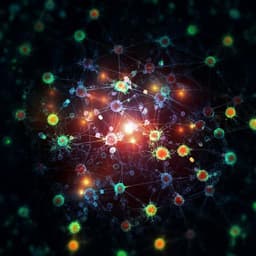Introduction
Mapping the brain's anatomical and connectomic structures is a major ongoing neuroscience endeavor. While complete nanoscale reconstructions exist for smaller nervous systems (e.g., *C. elegans*, *C. intestinalis*, *P. dumerilii*, *D. melanogaster* larva), larger brains (human, mouse, fruit fly, zebrafish) have only yielded partial reconstructions, posing significant big data challenges. Analyzing these massive datasets requires careful selection of informative structural properties. Complexity in neuronal structure has often been quantified using fractal dimension (*d*<sub>f</sub>), reflecting scale invariance or self-similarity. This self-similarity is observed across multiple scales in the brain, from macroscale gyrification to microscale dendritic branching. However, the relationship between these spatial features and functional properties remains poorly understood. This study proposes a framework from statistical physics to identify and quantify additional structural features. By treating partial cells within sampled volumes as clusters, the authors analyze properties like cell size distributions and spatial correlations to investigate whether the cellular structure exhibits signatures of collective phenomena near criticality.
Literature Review
Previous research has used fractal dimension (*d*<sub>f</sub>) to quantify neuronal complexity, with values ranging between 1.1 and 1.9. This metric reflects the scale invariance observed in brain structure across various scales, including macroscale gyrification, multiscale connectomes, and microscale dendritic branching. However, the functional implications of this self-similarity remain elusive. The authors' approach draws upon the study of critical systems in statistical physics to provide a more comprehensive framework for analyzing the structural complexity of the brain.
Methodology
The study utilizes publicly available volumetric brain datasets (~1 mm³ each) from human, mouse, and fruit fly brains. Electron microscopy images were segmented to identify individual cells. The researchers randomly sampled volumetric regions (2D slices and 3D volumes) from the segmentation data, treating partial cells within each sample as "segments" or clusters. They generated thousands of samples of varying sizes (L) to investigate finite-size effects. Critical exponents were estimated by analyzing the scaling properties of various structural features:
1. **Mean size of the largest segment (µ):** The relationship µ(L) ~ L<sup>d</sup> was investigated using finite-size scaling (FSS) to extrapolate the fractal dimension (*d*<sup>f</sup>) in the large-L limit.
2. **Box-counting fractal dimension (*d*<sub>box</sub><sup>(f)</sup>):** This method was applied to individual neuron reconstructions to assess their fractal properties.
3. **Mean segment size per voxel (S):** S(L) ~ L<sup>γ/ν</sup> was analyzed using FSS to estimate the exponent γ/ν, related to susceptibility and correlation length exponents.
4. **Segment size distribution:** The distribution's slow decay over several orders of magnitude was assessed as evidence for criticality.
5. **Two-point correlation function C(r):** This function measures the probability that two points at separation r belong to the same segment, exhibiting long-range correlations at criticality (C(r) ∼ r<sup>-(d-2+η)</sup>).
6. **Gap-size statistics n(s):** This captures higher-order correlations related to segment concavity, scaling as n(s) ∼ s<sup>-ζ</sup> at criticality.
FSS techniques were employed to extrapolate the critical exponents in the thermodynamic limit. Hyperscaling violation was also examined by analyzing the hyperscaling violation exponent (δ). Finally, the fraction of samples containing spanning clusters and cumulants of the order parameter were considered to assess the proximity of brain structure to criticality.
Key Findings
The analysis revealed that the cellular structure of the brain exhibits signatures of structural criticality, characterized by self-similarity and long-range correlations. Critical exponents were estimated for each organism (human, mouse, fruit fly) using various methods. The key findings are:
1. **Consistent fractal dimension:** The fractal dimension (*d*<sup>f</sup>) obtained through FSS analysis was approximately 1.6 across all three organisms.
2. **Critical scaling relations:** The estimated critical exponents obeyed scaling relations expected in critical systems, providing strong evidence for structural criticality.
3. **Cross-organism consistency of exponents:** The critical exponents were largely compatible between the human, mouse, and fruit fly brains, suggesting the existence of a structural brain universality class.
4. **Long-range correlations:** Long-range correlations were observed in pairwise correlations (C(r)) and higher-order correlations (n(s)), consistent with critical behavior.
5. **Hyperscaling violation:** Hyperscaling was found to be violated in all three species, with a hyperscaling violation exponent (δ) around 1.
6. **Neuron-specific analysis:** Analysis restricted to neuron segments yielded qualitatively similar results, indicating that the large-scale structural properties are dominated by neurons.
7. **Proximity to criticality:** Analysis of spanning cluster fractions and cumulants of the order parameter suggested that the brain structure may be slightly in the ordered phase, but near the critical point.
Discussion
The findings strongly suggest that the cellular structure of the brain, across multiple species, displays properties consistent with a critical system. The consistency of critical exponents between organisms implies the existence of a structural universality class, which could guide the development of generative models for brain anatomy. Such models could be used to predict other universal aspects of brain structure and facilitate cross-species comparisons. The observed structural criticality could be related to the optimal processing properties previously observed in neuronal avalanches. However, the relationship between these phenomena remains an open question. Furthermore, the study explores the potential link between cellular-level structural criticality and higher-level brain organization and network properties.
Conclusion
This study demonstrates that the cellular structure of the brain exhibits signatures of structural criticality, with consistent critical exponents across different organisms. This suggests a fundamental principle underlying brain organization. The findings pave the way for developing generative models of brain structure and a deeper understanding of the relationship between brain structure and function. Future research should explore broader brain regions, additional organisms, and incorporate dynamic aspects of brain development and function.
Limitations
The study's analysis is limited by the size and resolution of available datasets. The datasets used represent only partial brain regions in three organisms, and full proofreading of all cells was not available in all datasets. This could impact the accuracy of exponent estimation, particularly at larger length scales. Furthermore, the interpretation of spanning clusters as a meaningful order parameter for the brain requires further investigation.
Related Publications
Explore these studies to deepen your understanding of the subject.






